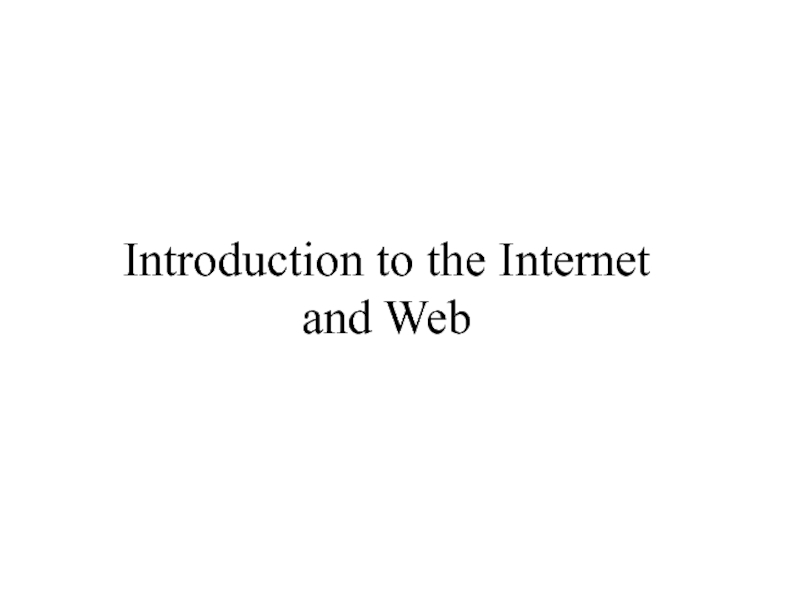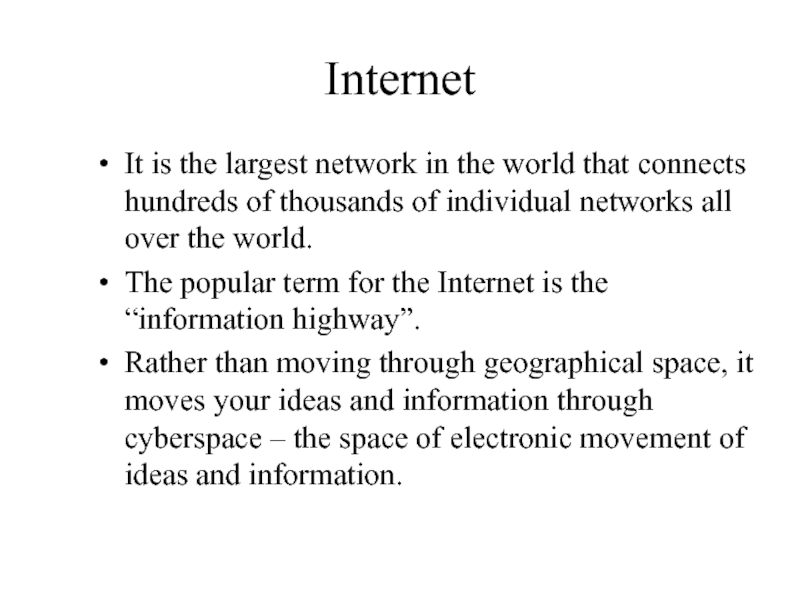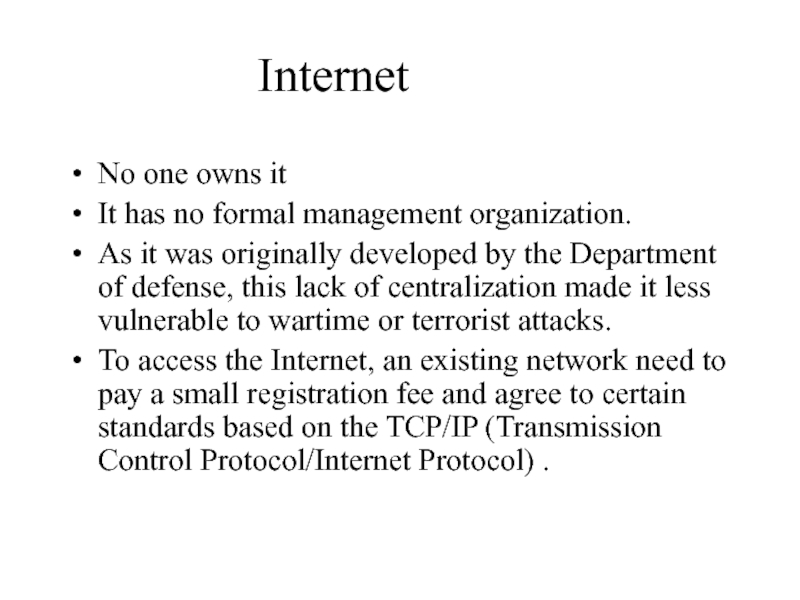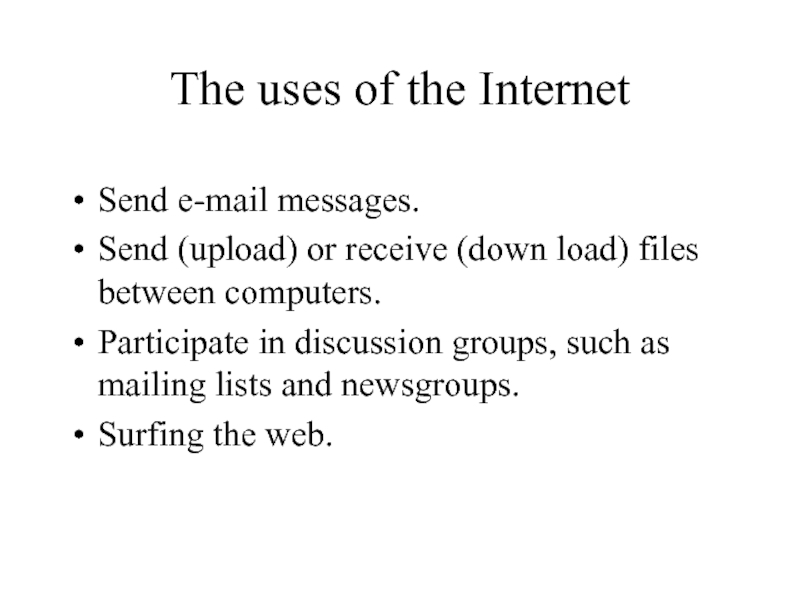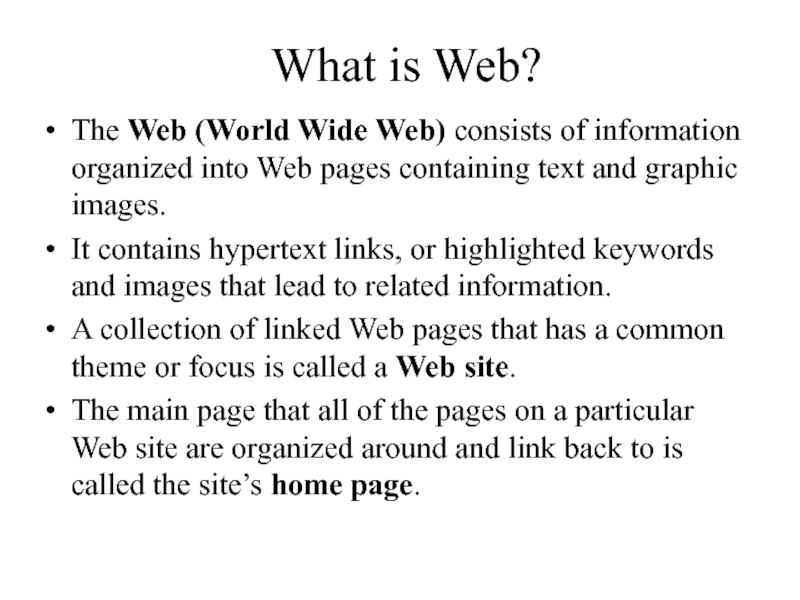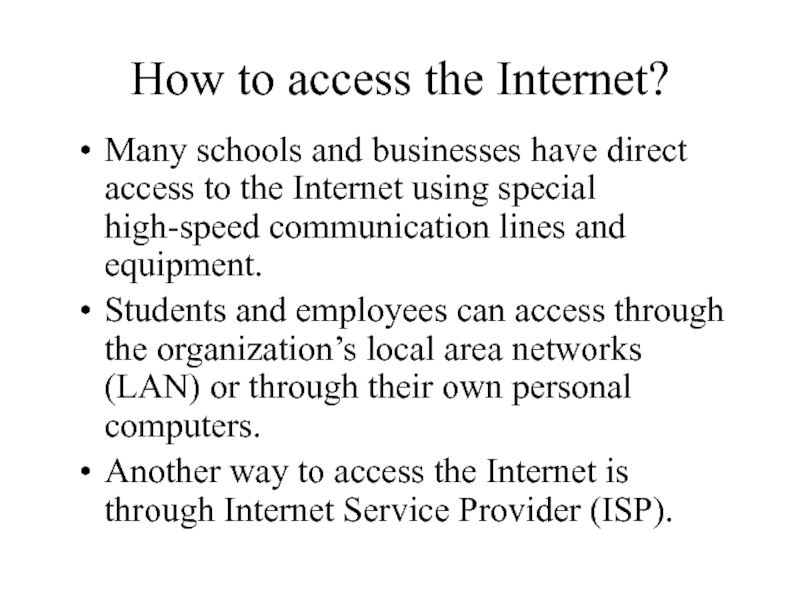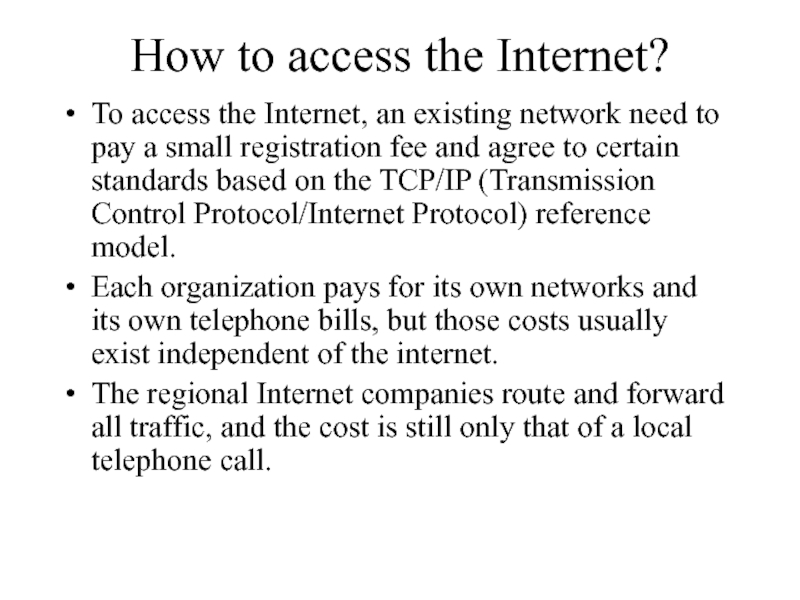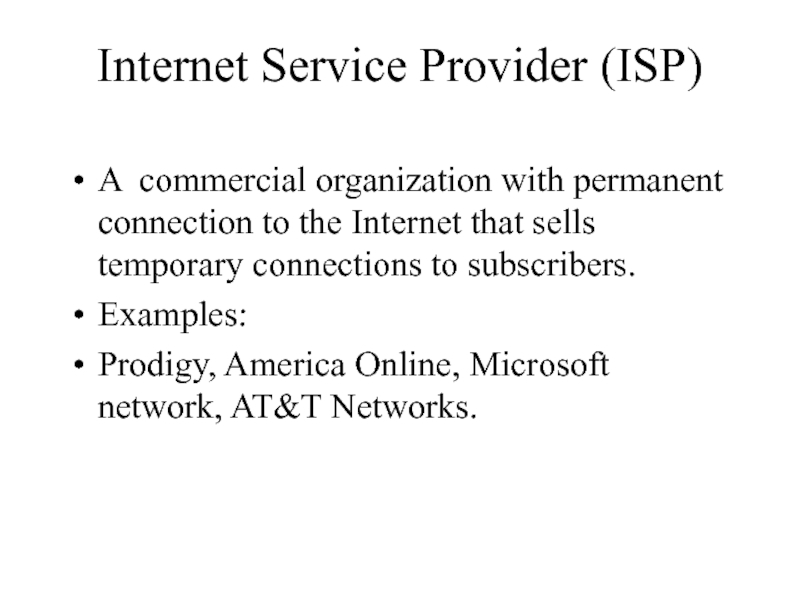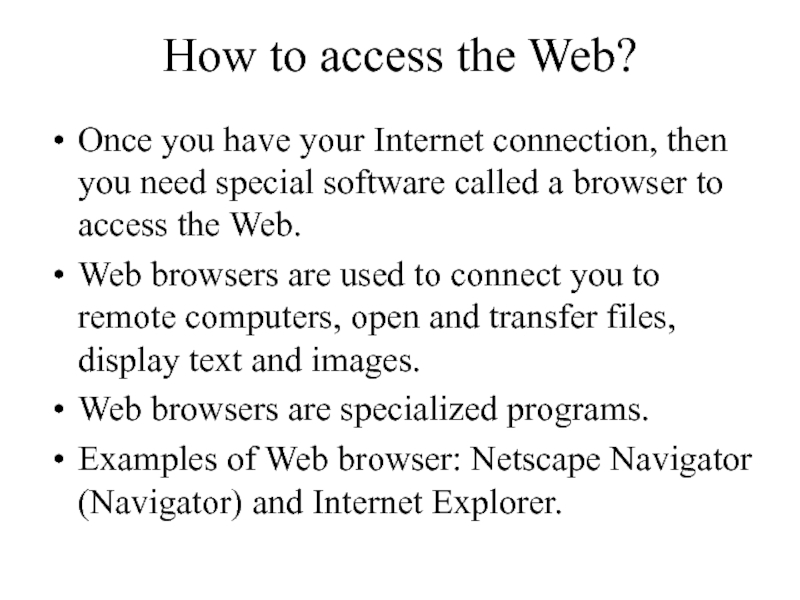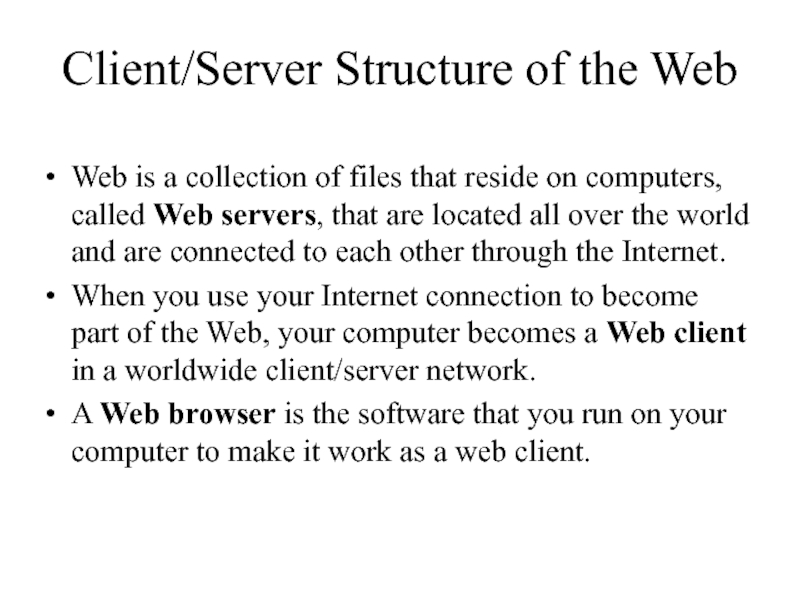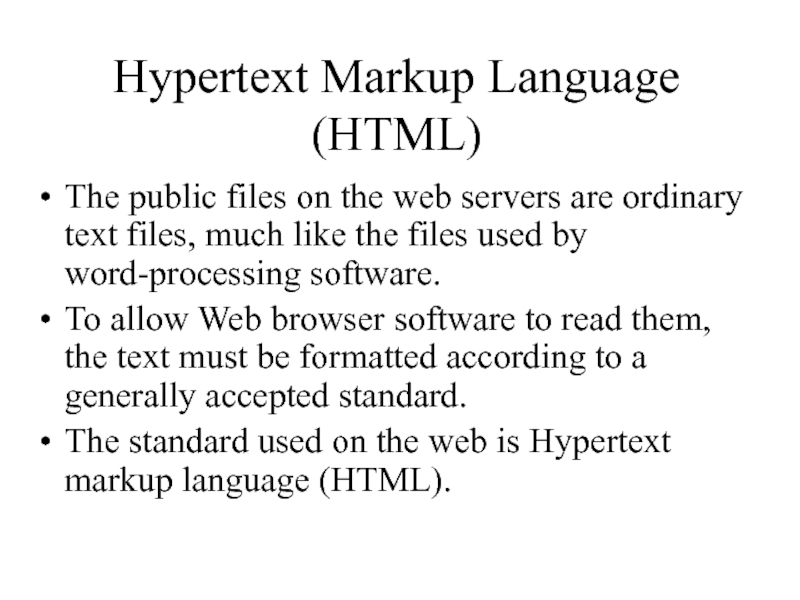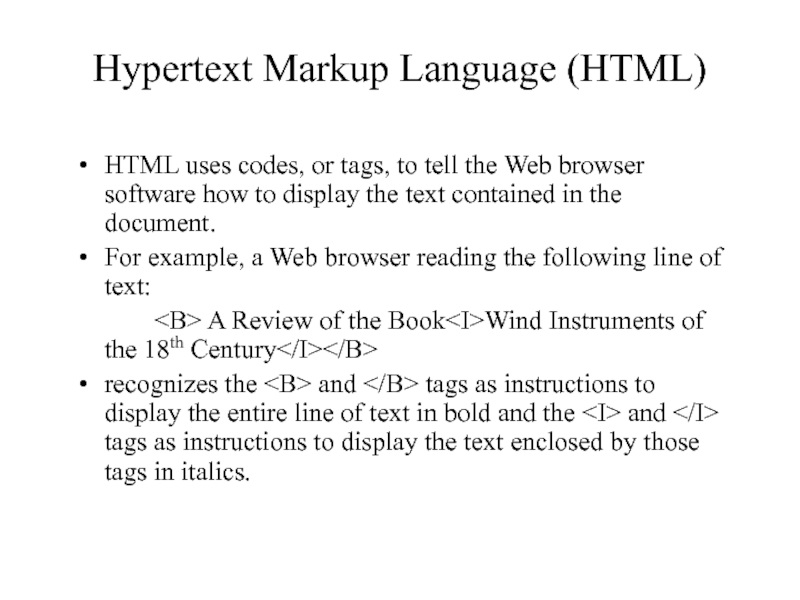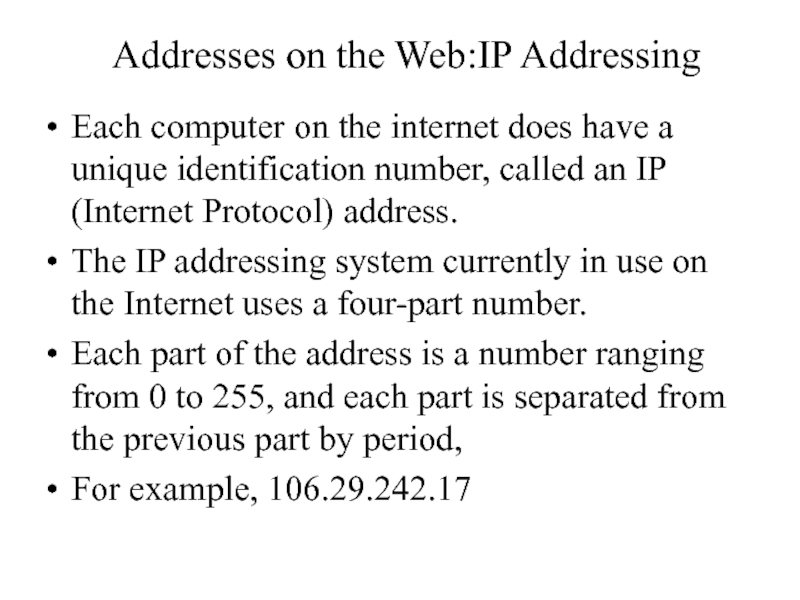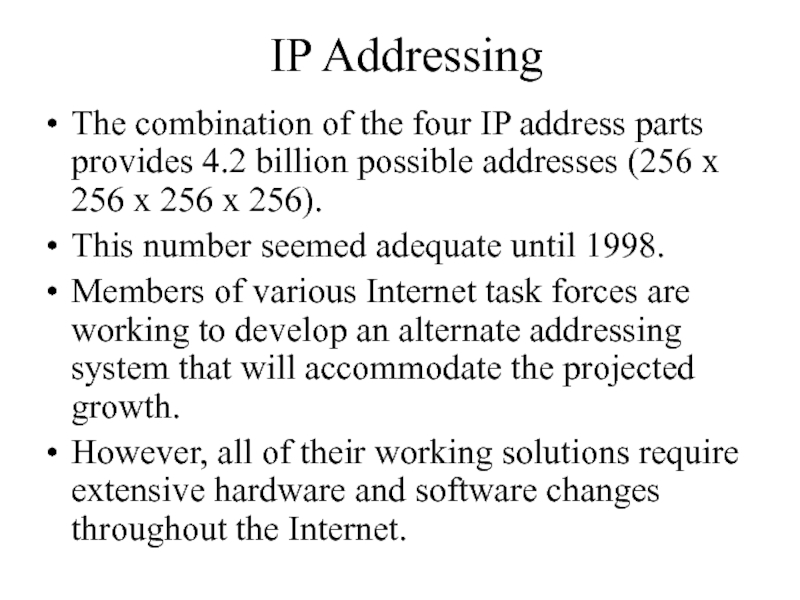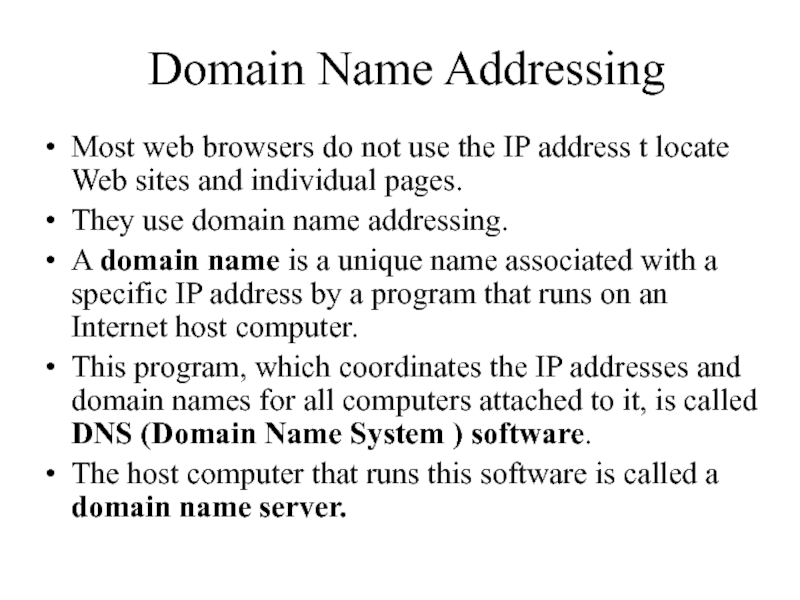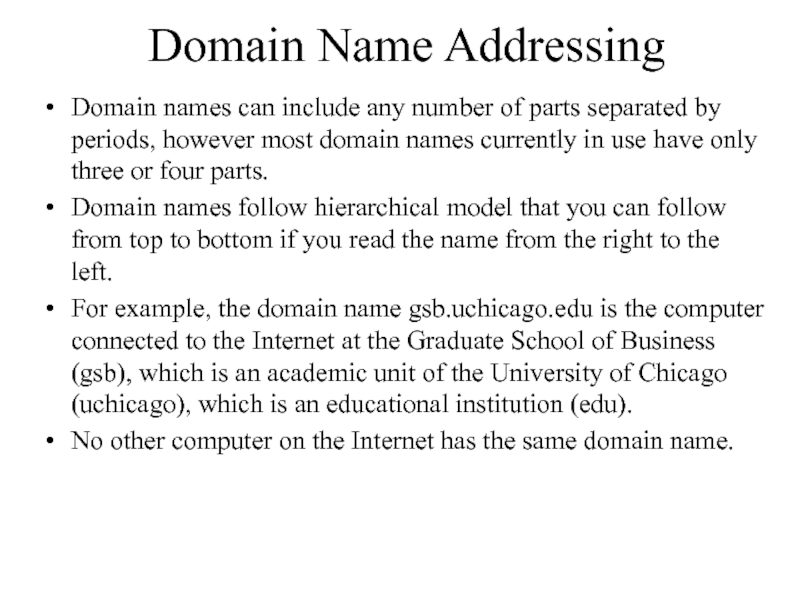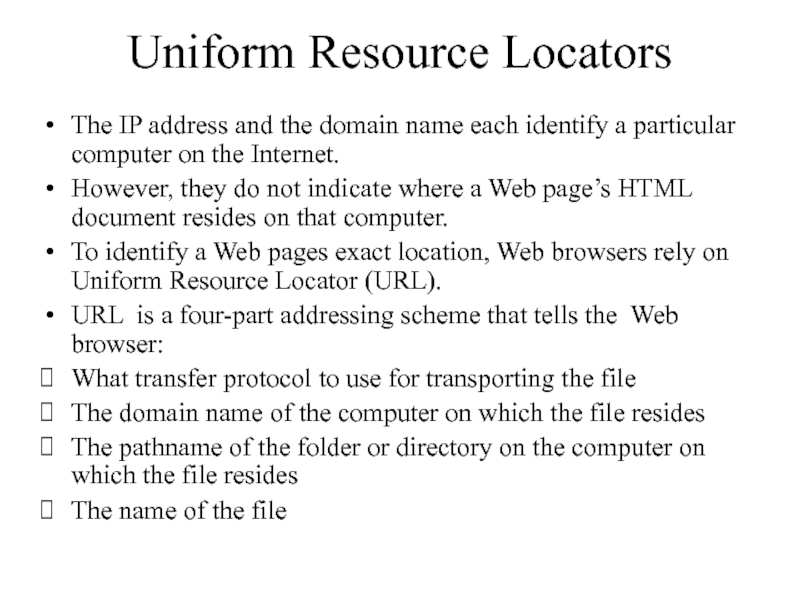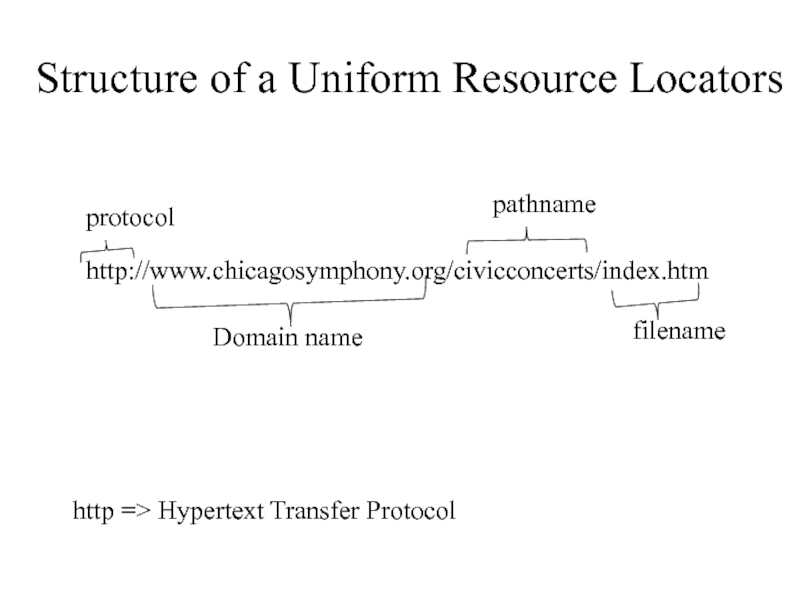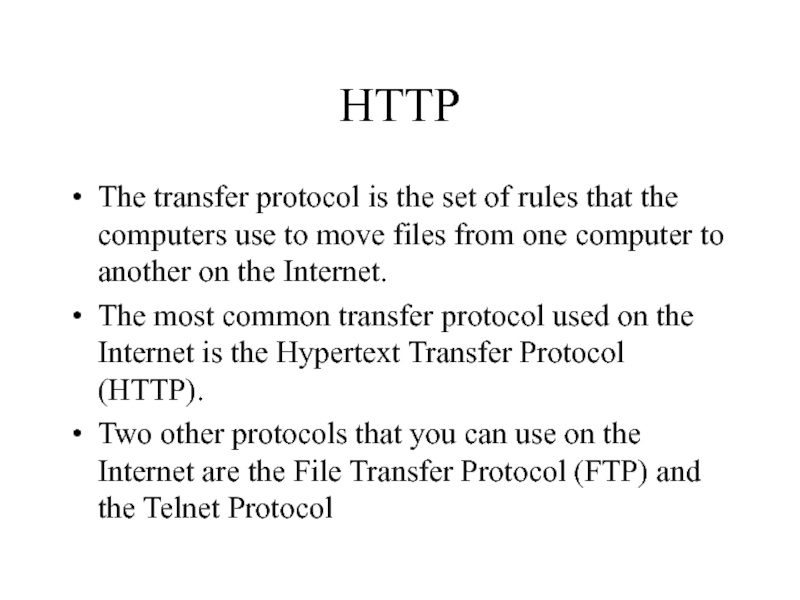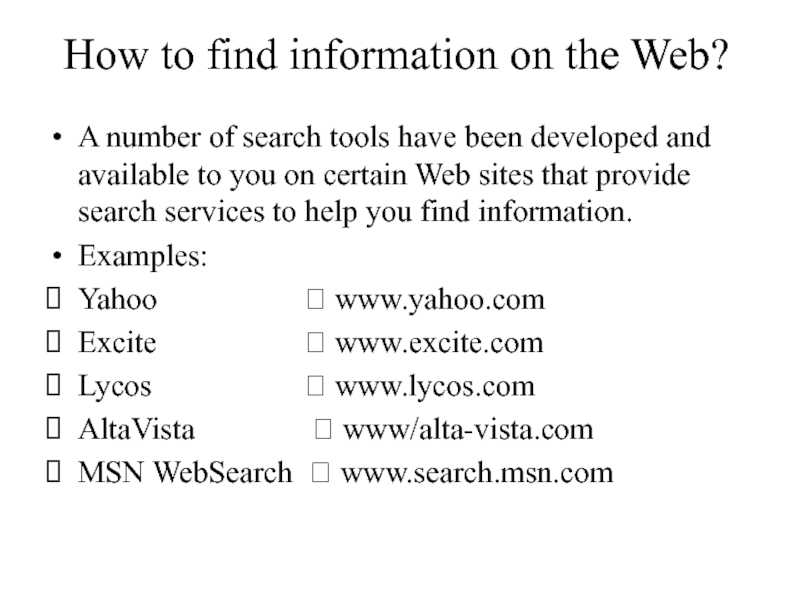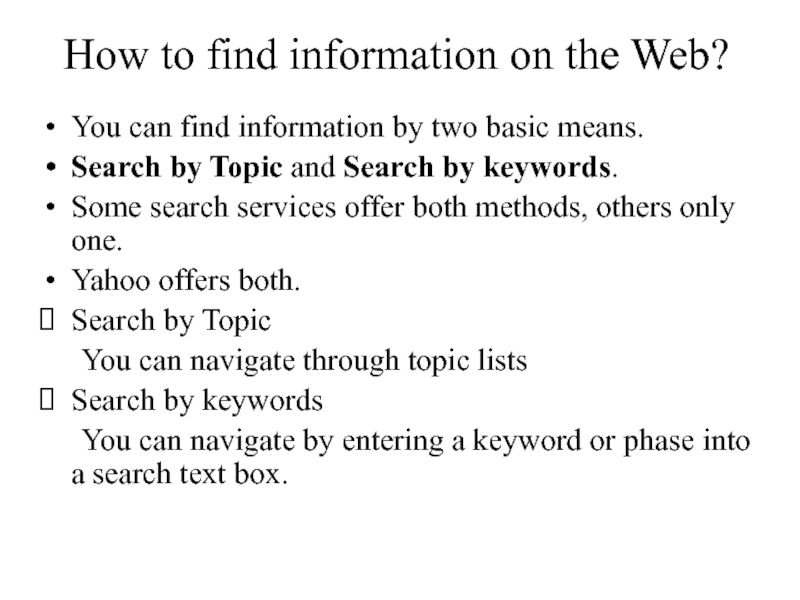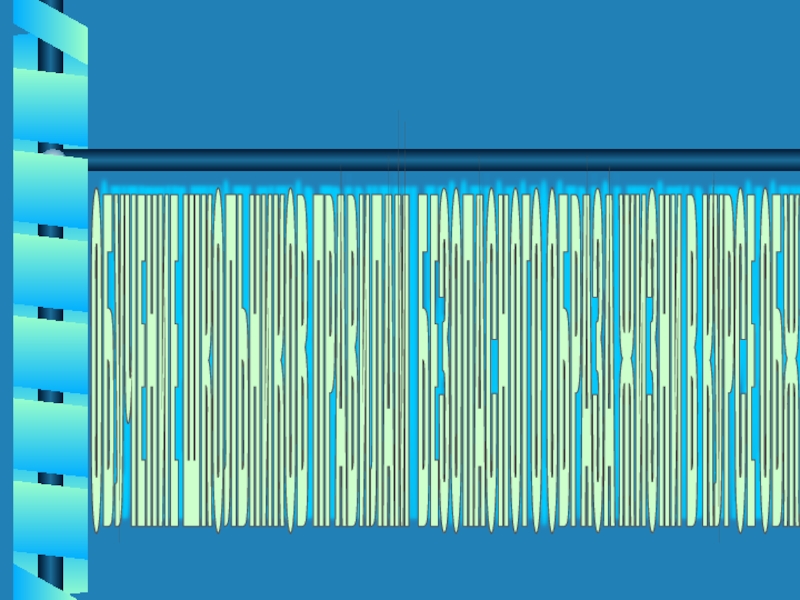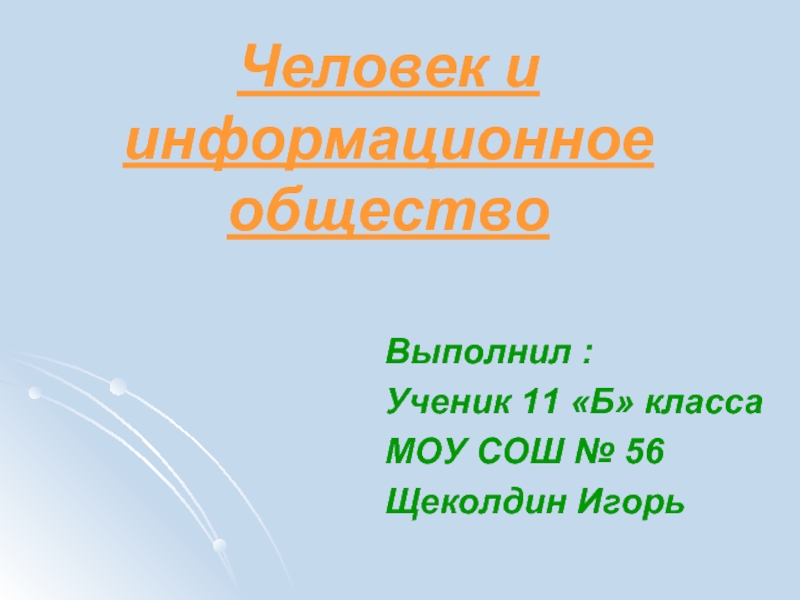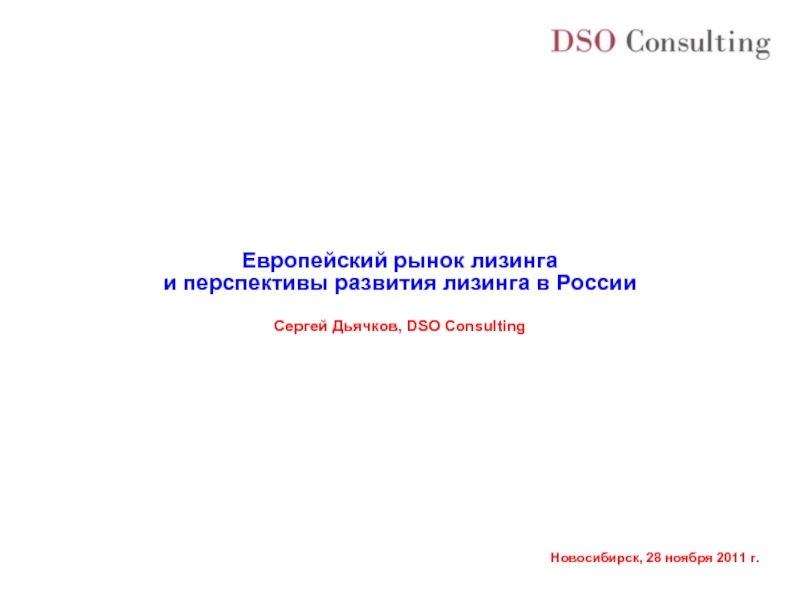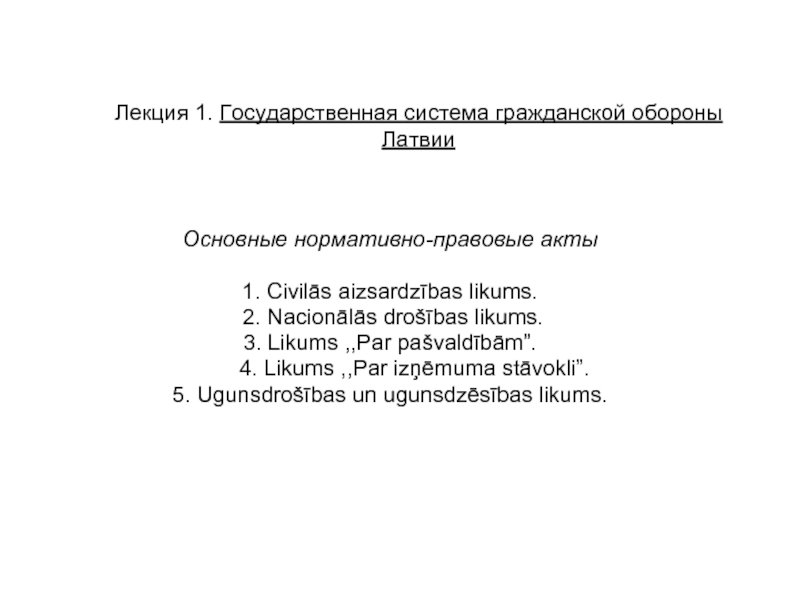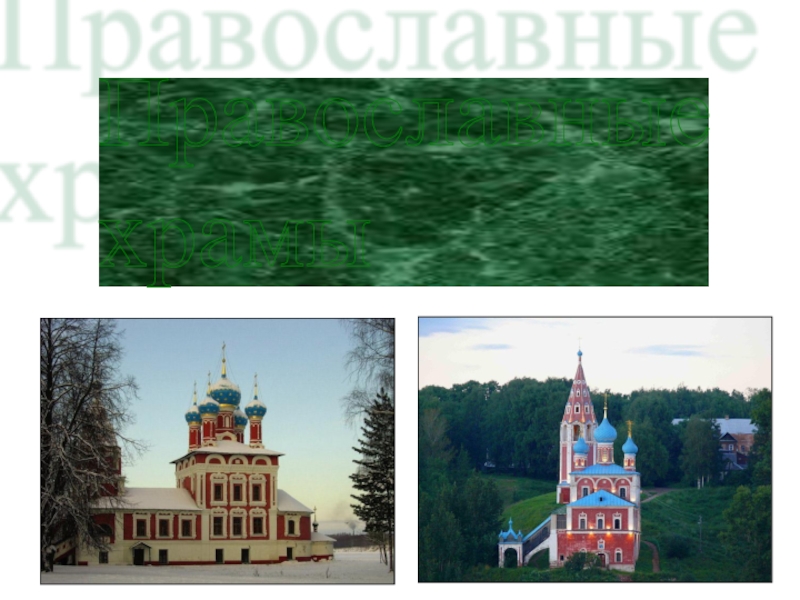- Главная
- Разное
- Дизайн
- Бизнес и предпринимательство
- Аналитика
- Образование
- Развлечения
- Красота и здоровье
- Финансы
- Государство
- Путешествия
- Спорт
- Недвижимость
- Армия
- Графика
- Культурология
- Еда и кулинария
- Лингвистика
- Английский язык
- Астрономия
- Алгебра
- Биология
- География
- Детские презентации
- Информатика
- История
- Литература
- Маркетинг
- Математика
- Медицина
- Менеджмент
- Музыка
- МХК
- Немецкий язык
- ОБЖ
- Обществознание
- Окружающий мир
- Педагогика
- Русский язык
- Технология
- Физика
- Философия
- Химия
- Шаблоны, картинки для презентаций
- Экология
- Экономика
- Юриспруденция
Introduction to the Internet and Web презентация
Содержание
- 1. Introduction to the Internet and Web
- 2. Internet It is the largest network in
- 3. Internet No one owns it It has
- 4. The uses of the Internet Send e-mail
- 5. What is Web? The Web (World Wide
- 6. How to access the Internet? Many schools
- 7. How to access the Internet? To access
- 8. Internet Service Provider (ISP) A commercial organization
- 9. How to access the Web? Once you
- 10. Client/Server Structure of the Web Web is
- 11. Hypertext Markup Language (HTML) The public files
- 12. Hypertext Markup Language (HTML) HTML uses codes,
- 13. Addresses on the Web:IP Addressing Each computer
- 14. IP Addressing The combination of the four
- 15. Domain Name Addressing Most web browsers do
- 16. Domain Name Addressing Domain names can include
- 17. Uniform Resource Locators The IP address and
- 18. Structure of a Uniform Resource Locators http://www.chicagosymphony.org/civicconcerts/index.htm
- 19. HTTP The transfer protocol is the set
- 20. How to find information on the Web?
- 21. How to find information on the Web?
Слайд 2Internet
It is the largest network in the world that connects hundreds
of thousands of individual networks all over the world.
The popular term for the Internet is the “information highway”.
Rather than moving through geographical space, it moves your ideas and information through cyberspace – the space of electronic movement of ideas and information.
The popular term for the Internet is the “information highway”.
Rather than moving through geographical space, it moves your ideas and information through cyberspace – the space of electronic movement of ideas and information.
Слайд 3Internet
No one owns it
It has no formal management organization.
As it was
originally developed by the Department of defense, this lack of centralization made it less vulnerable to wartime or terrorist attacks.
To access the Internet, an existing network need to pay a small registration fee and agree to certain standards based on the TCP/IP (Transmission Control Protocol/Internet Protocol) .
To access the Internet, an existing network need to pay a small registration fee and agree to certain standards based on the TCP/IP (Transmission Control Protocol/Internet Protocol) .
Слайд 4The uses of the Internet
Send e-mail messages.
Send (upload) or receive (down
load) files between computers.
Participate in discussion groups, such as mailing lists and newsgroups.
Surfing the web.
Participate in discussion groups, such as mailing lists and newsgroups.
Surfing the web.
Слайд 5What is Web?
The Web (World Wide Web) consists of information organized
into Web pages containing text and graphic images.
It contains hypertext links, or highlighted keywords and images that lead to related information.
A collection of linked Web pages that has a common theme or focus is called a Web site.
The main page that all of the pages on a particular Web site are organized around and link back to is called the site’s home page.
It contains hypertext links, or highlighted keywords and images that lead to related information.
A collection of linked Web pages that has a common theme or focus is called a Web site.
The main page that all of the pages on a particular Web site are organized around and link back to is called the site’s home page.
Слайд 6How to access the Internet?
Many schools and businesses have direct access
to the Internet using special high-speed communication lines and equipment.
Students and employees can access through the organization’s local area networks (LAN) or through their own personal computers.
Another way to access the Internet is through Internet Service Provider (ISP).
Students and employees can access through the organization’s local area networks (LAN) or through their own personal computers.
Another way to access the Internet is through Internet Service Provider (ISP).
Слайд 7How to access the Internet?
To access the Internet, an existing network
need to pay a small registration fee and agree to certain standards based on the TCP/IP (Transmission Control Protocol/Internet Protocol) reference model.
Each organization pays for its own networks and its own telephone bills, but those costs usually exist independent of the internet.
The regional Internet companies route and forward all traffic, and the cost is still only that of a local telephone call.
Each organization pays for its own networks and its own telephone bills, but those costs usually exist independent of the internet.
The regional Internet companies route and forward all traffic, and the cost is still only that of a local telephone call.
Слайд 8Internet Service Provider (ISP)
A commercial organization with permanent connection to the
Internet that sells temporary connections to subscribers.
Examples:
Prodigy, America Online, Microsoft network, AT&T Networks.
Examples:
Prodigy, America Online, Microsoft network, AT&T Networks.
Слайд 9How to access the Web?
Once you have your Internet connection, then
you need special software called a browser to access the Web.
Web browsers are used to connect you to remote computers, open and transfer files, display text and images.
Web browsers are specialized programs.
Examples of Web browser: Netscape Navigator (Navigator) and Internet Explorer.
Web browsers are used to connect you to remote computers, open and transfer files, display text and images.
Web browsers are specialized programs.
Examples of Web browser: Netscape Navigator (Navigator) and Internet Explorer.
Слайд 10Client/Server Structure of the Web
Web is a collection of files that
reside on computers, called Web servers, that are located all over the world and are connected to each other through the Internet.
When you use your Internet connection to become part of the Web, your computer becomes a Web client in a worldwide client/server network.
A Web browser is the software that you run on your computer to make it work as a web client.
When you use your Internet connection to become part of the Web, your computer becomes a Web client in a worldwide client/server network.
A Web browser is the software that you run on your computer to make it work as a web client.
Слайд 11Hypertext Markup Language (HTML)
The public files on the web servers are
ordinary text files, much like the files used by word-processing software.
To allow Web browser software to read them, the text must be formatted according to a generally accepted standard.
The standard used on the web is Hypertext markup language (HTML).
To allow Web browser software to read them, the text must be formatted according to a generally accepted standard.
The standard used on the web is Hypertext markup language (HTML).
Слайд 12Hypertext Markup Language (HTML)
HTML uses codes, or tags, to tell the
Web browser software how to display the text contained in the document.
For example, a Web browser reading the following line of text:
A Review of the BookWind Instruments of the 18th Century
recognizes the and tags as instructions to display the entire line of text in bold and the and tags as instructions to display the text enclosed by those tags in italics.
For example, a Web browser reading the following line of text:
A Review of the BookWind Instruments of the 18th Century
recognizes the and tags as instructions to display the entire line of text in bold and the and tags as instructions to display the text enclosed by those tags in italics.
Слайд 13Addresses on the Web:IP Addressing
Each computer on the internet does have
a unique identification number, called an IP (Internet Protocol) address.
The IP addressing system currently in use on the Internet uses a four-part number.
Each part of the address is a number ranging from 0 to 255, and each part is separated from the previous part by period,
For example, 106.29.242.17
The IP addressing system currently in use on the Internet uses a four-part number.
Each part of the address is a number ranging from 0 to 255, and each part is separated from the previous part by period,
For example, 106.29.242.17
Слайд 14IP Addressing
The combination of the four IP address parts provides 4.2
billion possible addresses (256 x 256 x 256 x 256).
This number seemed adequate until 1998.
Members of various Internet task forces are working to develop an alternate addressing system that will accommodate the projected growth.
However, all of their working solutions require extensive hardware and software changes throughout the Internet.
This number seemed adequate until 1998.
Members of various Internet task forces are working to develop an alternate addressing system that will accommodate the projected growth.
However, all of their working solutions require extensive hardware and software changes throughout the Internet.
Слайд 15Domain Name Addressing
Most web browsers do not use the IP address
t locate Web sites and individual pages.
They use domain name addressing.
A domain name is a unique name associated with a specific IP address by a program that runs on an Internet host computer.
This program, which coordinates the IP addresses and domain names for all computers attached to it, is called DNS (Domain Name System ) software.
The host computer that runs this software is called a domain name server.
They use domain name addressing.
A domain name is a unique name associated with a specific IP address by a program that runs on an Internet host computer.
This program, which coordinates the IP addresses and domain names for all computers attached to it, is called DNS (Domain Name System ) software.
The host computer that runs this software is called a domain name server.
Слайд 16Domain Name Addressing
Domain names can include any number of parts separated
by periods, however most domain names currently in use have only three or four parts.
Domain names follow hierarchical model that you can follow from top to bottom if you read the name from the right to the left.
For example, the domain name gsb.uchicago.edu is the computer connected to the Internet at the Graduate School of Business (gsb), which is an academic unit of the University of Chicago (uchicago), which is an educational institution (edu).
No other computer on the Internet has the same domain name.
Domain names follow hierarchical model that you can follow from top to bottom if you read the name from the right to the left.
For example, the domain name gsb.uchicago.edu is the computer connected to the Internet at the Graduate School of Business (gsb), which is an academic unit of the University of Chicago (uchicago), which is an educational institution (edu).
No other computer on the Internet has the same domain name.
Слайд 17Uniform Resource Locators
The IP address and the domain name each identify
a particular computer on the Internet.
However, they do not indicate where a Web page’s HTML document resides on that computer.
To identify a Web pages exact location, Web browsers rely on Uniform Resource Locator (URL).
URL is a four-part addressing scheme that tells the Web browser:
What transfer protocol to use for transporting the file
The domain name of the computer on which the file resides
The pathname of the folder or directory on the computer on which the file resides
The name of the file
However, they do not indicate where a Web page’s HTML document resides on that computer.
To identify a Web pages exact location, Web browsers rely on Uniform Resource Locator (URL).
URL is a four-part addressing scheme that tells the Web browser:
What transfer protocol to use for transporting the file
The domain name of the computer on which the file resides
The pathname of the folder or directory on the computer on which the file resides
The name of the file
Слайд 18Structure of a Uniform Resource Locators
http://www.chicagosymphony.org/civicconcerts/index.htm
protocol
Domain name
pathname
filename
http => Hypertext Transfer Protocol
Слайд 19HTTP
The transfer protocol is the set of rules that the computers
use to move files from one computer to another on the Internet.
The most common transfer protocol used on the Internet is the Hypertext Transfer Protocol (HTTP).
Two other protocols that you can use on the Internet are the File Transfer Protocol (FTP) and the Telnet Protocol
The most common transfer protocol used on the Internet is the Hypertext Transfer Protocol (HTTP).
Two other protocols that you can use on the Internet are the File Transfer Protocol (FTP) and the Telnet Protocol
Слайд 20How to find information on the Web?
A number of search tools
have been developed and available to you on certain Web sites that provide search services to help you find information.
Examples:
Yahoo ? www.yahoo.com
Excite ? www.excite.com
Lycos ? www.lycos.com
AltaVista ? www/alta-vista.com
MSN WebSearch ? www.search.msn.com
Examples:
Yahoo ? www.yahoo.com
Excite ? www.excite.com
Lycos ? www.lycos.com
AltaVista ? www/alta-vista.com
MSN WebSearch ? www.search.msn.com
Слайд 21How to find information on the Web?
You can find information by
two basic means.
Search by Topic and Search by keywords.
Some search services offer both methods, others only one.
Yahoo offers both.
Search by Topic
You can navigate through topic lists
Search by keywords
You can navigate by entering a keyword or phase into a search text box.
Search by Topic and Search by keywords.
Some search services offer both methods, others only one.
Yahoo offers both.
Search by Topic
You can navigate through topic lists
Search by keywords
You can navigate by entering a keyword or phase into a search text box.
